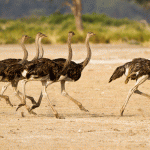
Running with proper forefoot or midfoot strike can be safe. Image: Shutterstock
With the London Olympics fast approaching we have a few tips to assist your athletic performance.
If you remember the 1960 Rome Olympics, or have otherwise heard the story, the first African to win Olympic Gold was Ethiopian marathon runner Abebe Bikila. He ran 42 kilometres without shoes. The athlete was used to barefoot running, but much scientific research has been conducted to explain the benefits of this practice.
“People who don’t wear shoes when they run have an astonishingly different strike,” says Daniel Lieberman, professor of Human Evolutionary Biology at Harvard University. “By landing on the middle or front of the foot, barefoot runners have almost no impact collision, much less than most shod runners generate when they heel-strike.”
After working with populations of runners in the United States and Kenya, the researchers looked at the running gaits of three groups: the barefoot runners, the shoe-wearing runners and those who had converted to barefoot running from shod running. They found that shod runners heel-strike, experiencing a very large and sudden collision force of about 1,600 times per kilometre. People who run barefoot, however, tend to land with a springy step towards the middle or front of the foot.
“Most people today think barefoot running is dangerous and hurts, but actually you can run barefoot on the world’s hardest surfaces without the slightest discomfort and pain,” Lieberman goes on to explain. “All you need is a few calluses to avoid roughing up the skin of the foot. Further, it might be less injurious than the way some people run in shoes.”
But professor Peter Milburn from Griffith University in Queensland says that we shouldn’t throw out our running shoes just yet.
“A runner must change the way they run, landing more on the mid-foot or forefoot rather than on the heel. The Achilles tendon and calf muscles will contract eccentrically to cushion this extra load. The end result, though, is that the unaccustomed strain on muscles and tendons will lead to injury — exactly what the change to barefoot running was supposed to prevent,” Milburn says.
To gain some of the benefits of barefoot running, one would have to learn how to walk barefoot before, as the body would need to accommodate to the new loads to avoid significant risk of injury. Nonetheless, as Lieberman and his team explain on their website, barefoot running is not for everyone: “Anyone who has sensory loss to the foot should not run barefoot. In fact, these individuals should probably wear shoes of some type at all times in order to protect their feet”¦ If you have any foot-related problems, you should seek the advice of medical professional before you start barefoot running.”
Source: Harvard University, Griffith University






